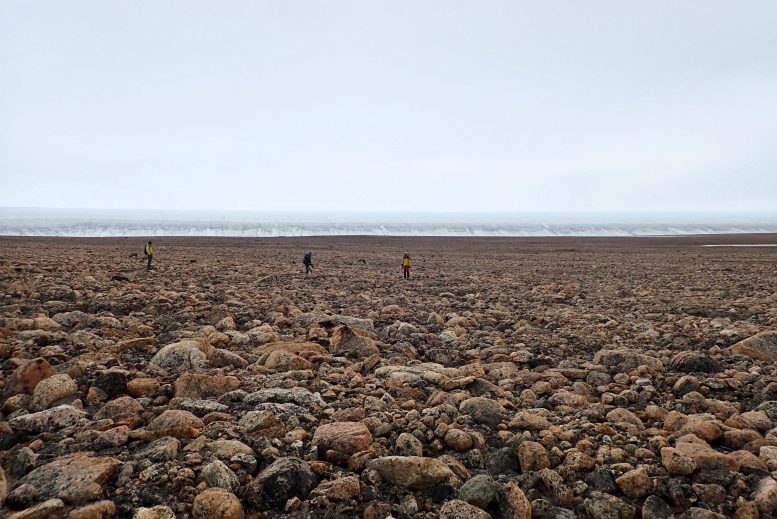قام باحثون دنماركيون وسويديون بتأريخ فوهة بركان هاواثا الضخمة ، وهي فوهة نيزكية بعرض 31 كم مدفونة تحت كيلومتر واحد من الجليد في جرينلاند. يضع التأريخ حداً للتكهنات بأن النيزك كان له تأثير بعد ظهور البشر ويفتح فهماً جديداً لتطور الأرض في عصر ما بعد الديناصورات.
منذ عام 2015 ، عندما اكتشف باحثون من معهد GLOBE التابع لجامعة كوبنهاغن حفرة تأثير Hiawatha في شمال غرب جرينلاند ، كان عدم اليقين بشأن عمر فوهة البركان موضوع الكثير من المناقشات. هل يمكن أن يكون الكويكب قد اصطدم بالأرض منذ 13000 عام فقط ، عندما كان البشر يسكنون الكوكب منذ فترة طويلة؟ هل يمكن أن يكون تأثيره قد حفز ما يقرب من 1000 عام من التبريد العالمي المعروف باسم Younger Dryas؟
تظهر التحليلات الجديدة التي أجريت على حبيبات الرمل والصخور من فوهة تأثير Hiawatha من قبل متحف التاريخ الطبيعي في الدنمارك ومعهد GLOBE في جامعة كوبنهاغن ، وكذلك المتحف السويدي للتاريخ الطبيعي في ستوكهولم ، أن الإجابة هي لا. فوهة تأثير Hiawatha أقدم بكثير. وبالفعل نشرت دراسة جديدة في المجلة تقدم العلماء تفيد تقارير اليوم (9 مارس 2022) أن عمرها 58 مليون سنة.

خرائط توضح موقع فوهة الارتطام Hiawatha في شمال غرب جرينلاند (على اليسار) وشكل سطح الأرض تحت الجليد ، مع وجود فوهة البركان مرئية بوضوح (على اليمين). الائتمان: جامعة كوبنهاغن
“كان تحديد تاريخ فوهة البركان مشكلة يصعب حلها بشكل خاص ، لذا فمن المُرضي للغاية أن مختبرين في الدنمارك والسويد ، باستخدام طرق مختلفة للتأريخ ، قد توصلا إلى نفس النتيجة. على هذا النحو ، أنا واثق من أننا حددنا العمر الحقيقي للحفرة ، وهو أقدم بكثير مما كان يعتقده كثيرون من قبل “، كما يقول مايكل ستوري من متحف التاريخ الطبيعي في الدنمارك.
يقول الدكتور جافين كيني من المتحف السويدي للطبيعة تاريخ.

بلورات معدن الزركون عبارة عن كبسولات زمنية صغيرة تسجل عمر العديد من الأحداث في تاريخ الأرض. كان تأريخ بلورات الزركون مثل هذه إحدى طريقتين مستخدمتين لحساب عمر فوهة تأثير Hiawatha. الائتمان: جامعة كوبنهاغن
كواحد من أولئك الذين ساعدوا في اكتشاف فوهة الارتطام Hiawatha في عام 2015 ، يسر الأستاذ Nicolaj Krog Larsen من معهد GLOBE التابع لجامعة كوبنهاغن تأكيد عمر الحفرة بالضبط.
“إنه لأمر رائع أن تعرف عمرها الآن. لقد عملنا بجد لإيجاد طريقة لتحديد تاريخ الحفرة منذ أن اكتشفناها قبل سبع سنوات. ومنذ ذلك الحين قمنا بعدة رحلات ميدانية إلى المنطقة. لجمع العينات المرتبطة بتأثير هياواثا “، كما يقول البروفيسور لارسن.
العمر الذي كشفته أشعة الليزر وحبوب الرمل
لم يكن هناك غطاء جليدي بسمك كيلومتر يغطي شمال غرب جرينلاند عندما اصطدم الكويكب هياواثا بسطح الأرض وأطلق طاقة تفوق طاقة القنبلة الذرية بملايين المرات. في ذلك الوقت ، كان القطب الشمالي مغطى بغابات مطيرة معتدلة ، وكثرت الحياة البرية – ودرجات حرارة تصل إلى 20 درجة[{” attribute=””>Celsius were the norm. Eight million years earlier, an even larger asteroid struck present-day Mexico, causing the extinction of Earth’s dinosaurs.

The NordSIMS laboratory at the Swedish Museum of Natural History, one of two labs where analyses were conducted to date the Hiawatha impact crater. Credit: University of Copenhagen
The asteroid smashed into Earth, leaving a thirty-one-kilometer-wide, one-kilometer-deep crater. The crater is big enough to contain the entire city of Washington D.C. Today, the crater lies beneath the Hiawatha Glacier in Northwest Greenland. Rivers flowing from the glacier supplied the researchers with sand and rocks that were superheated by the impact 58 million years ago.
The sand was analyzed at the Natural History Museum of Denmark by heating the grains with a laser until they released argon gas, whereas the rock samples were analyzed at the Swedish Museum of Natural History using uranium-lead dating of the mineral zircon.
Clear evidence that the Hiawatha impact disrupted global climate is still lacking. However, the crater’s dating allows the international research team working on the crater to begin testing various hypotheses to better understand what its impact was on both the local and global climate.
Facts:
- At 31 km across, the Hiawatha impact crater is larger than about 90% of the roughly 200 previously known impact craters on Earth.
- Although the Hiawatha impact crater is much smaller than the approximately 200 km-wide Chicxulub impact crater in present-day Mexico, which led to the demise of the dinosaurs, it would have devastated the region and may even have had wider consequences for the climate and plant and animal life.
- When the Hiawatha impact occurred 58 million years ago the Earth had recovered from the catastrophic effects of the Chicxulub impact eight million years earlier and was entering a long-term warming trend that was to last about 5 million years.
Reference: “A Late Paleocene age for Greenland’s Hiawatha impact structure” by Gavin G. Kenny, William R. Hyde, Michael Storey, Adam A. Garde, Martin J. Whitehouse, Pierre Beck, Leif Johansson, Anne Sofie Søndergaard, Anders A. Bjørk, Joseph A. MacGregor, Shfaqat A. Khan, Jérémie Mouginot, Brandon C. Johnson, Elizabeth A. Silber, Daniel K. P. Wielandt, Kurt H. Kjær and Nicolaj K. Larsen, 9 March 2022, Science Advances.
DOI: 10.1126/sciadv.abm2434

“هواة الإنترنت المتواضعين بشكل يثير الغضب. مثيري الشغب فخور. عاشق الويب. رجل أعمال. محامي الموسيقى الحائز على جوائز.”







